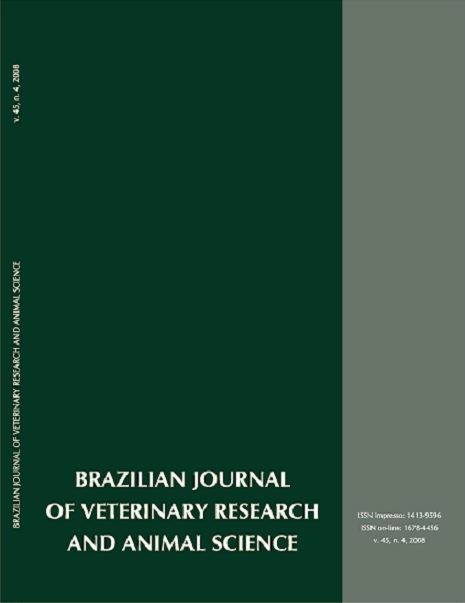Histopathological examination of lymphoid organs in cattle and mice experimentally poisoned by Baccharis coridifolia: Immunohistochemical characterization of B and T lymphocytes
DOI:
https://doi.org/10.11606/issn.1678-4456.bjvras.2008.26686Keywords:
Baccharis coridifolia, Toxic plants, Lymphoid necrosis, Cattle, MiceAbstract
Baccharis coridifolia is one of the most important poisonous plants to cattle in the South of Brazil. The plant provokes necrotic lesions in the lymphoid tissues and in the gastrointestinal tract of cattle. Experimental administration to mice produces most of the lesions seen in the lymphoid tissues of cattle. This study was conducted to search possible differences in the susceptibility of T and B lymphocyte subpopulations. Lymph nodes, spleen, thymus and gut-associated lymphoid tissue (GALT) of cattle and mice experimentally poisoned were evaluated. The results were evaluated based on cell populations affected or remaining in the organs. Immunostaining for B lymphocytes (anti-BLA-36) identified the germinal center of follicles of the lymph node, spleen and GALT in both species. Immunostaining for T lymphocyte (anti-CD3) identified the paracortical area of the germinal centers of the lymph nodes and GALT, the periarteriolar area of the spleen, and the whole thymus both in cattle and mice. Experimentally poisoned cattle and mice shows necrosis of the germinal center of secondary follicles of the lymph nodes, spleen and GALT, where necrotic cells were immunostained for B and less often for T lymphocyte. Necrotic cells in the paracortical region of the lymph node were less often and were immunostained. Necrotic lesions of the thymus were seen only in mice, with positively stained for T lymphocyte. The distribution of the lesions in the lymphoid tissues and the immunostaining in necrotic cells suggested that the active principles of the plant are cytotoxic to B and T cells.Downloads
Download data is not yet available.
Downloads
Published
2008-08-01
Issue
Section
UNDEFINIED
License
The journal content is authorized under the Creative Commons BY-NC-SA license (summary of the license: https://
How to Cite
1.
Varaschin MS, Alessi AC. Histopathological examination of lymphoid organs in cattle and mice experimentally poisoned by Baccharis coridifolia: Immunohistochemical characterization of B and T lymphocytes. Braz. J. Vet. Res. Anim. Sci. [Internet]. 2008 Aug. 1 [cited 2025 Dec. 30];45(4):277-83. Available from: https://revistas.usp.br/bjvras/article/view/26686





